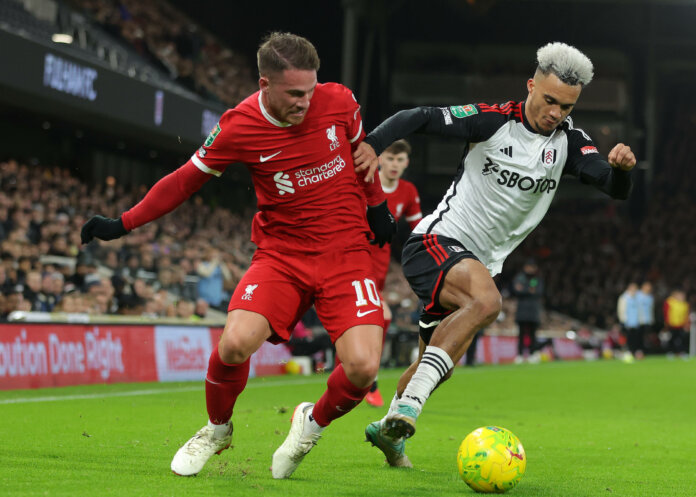Crafting the Future: Alexis Mac Allister’s Role at Liverpool
The Midfield Transformation
After signing Brighton’s World Cup-winning superstar, Alexis Mac Allister, I saw him as Liverpool’s long-term Thiago Alcântara replacement. This player could help lessen the load of the fragile and ageing controller. Despite the continuing injury issues surrounding the Spaniard’s Anfield stay, no one could have envisioned just how long the former Barca man would be missing, as his final game for the Reds may have already occurred.
Two notable positive differences.
Alexis Mac Allister playing deeper, allows dictation.
A full back that runs up and down the wing… Jones is doing it well.
— 🅘 (@LFCApproved) February 10, 2024
The fact that a readymade replacement was ushered through the regeneration door (in the summer of 2023), was preparation which was immediately scuppered by an inability to land either option A or option B, of the listed defensive midfield targets. It is clear that before Wataru Endō eventually arrived from Stuttgart, there was a desire to recruit an energetic and elite destroyer into the first team elite. Moisés Caicedo and Roméo Lavia were the assumed options A & B, respectively, who both ended up at the circus known as Stamford Bridge. Though the form and consistency of the Japan captain gradually rose from worrying to very good, that bedding-in period has come at a cost to his teammate, Alexis Mac Allister.
Navigating the Midfield Maze
The interim period of learning to play on Jürgen Klopp’s side is often longer for midfielders and fullbacks, given the need to always be positionally correct. The off-ball characteristics would have seen Wataru Endō having to play higher and more aggressively in his play (than in the Bundesliga). In contrast, the on-ball initiative always demands far more confidence and control. The latter part of the adjustment was the most worrying, so an early-season decision was made to re-task Alexis Mac Allister, thereby dropping him into the defensive midfield role. At the outset of that endeavour, his performances were littered with good and bad moments. However, since his return from injury (around Christmas), the 25-year-old has looked stronger and more refined in his holding role performances.
Alexis Mac Allister with just 27 touches in that half – only Darwin Nunez (22) and Caoimhin Kelleher (19) had fewer for Liverpool. Always feel he struggles to influence games further forward and that it weaken's Liverpool's ability to pass through the opposition formation.
— David Lynch (@dmlynchlfc) February 10, 2024
The Burnley Game: A Tactical Insight
The transition period from a more front-footed midfielder to a deep-lying ball winner was undertaken due to circumstances, which was then reversed in the most recent Liverpool game, as Burnley travelled to Anfield for their Premier League encounter. The loss of Dominik Szoboszlai to injury and the return of the 30-year-old Asia Cup participant, Wataru Endō, meant that the AXA Training Centre coaching staff ordered a reshuffle of the middle ground. The thought process in starting eleven was sound, as Alexis would replace the Hungarian skipper on the right, as the Japan ball winner returned to his natural role. Curtis Jones rightly continued his left-sided role, and the trio of starting pieces was complete.
The issue was the positional effect that this role change had on the former Argentinos Juniors academy graduate, who spent most of his first half as a non-entity. Much of the natural space around the £35m signing was occupied by the advancing and hybrid-hungry Trent Alexander Arnold, who was more familiar with a ball-carrying and far more direct midfielder (like Dominik) ahead of him. Therefore, the need to push on and become part of the attacking group was thrust upon the 5ft 9inch controller, who seemed somewhat lost when away from his deeper position.
Only in the second half (after the injury and substitution of the vice-captain), was Macca able to switch sides and allow Harvey Elliott into the more industrious role. Curtis Jones moved to right fullback, which enabled the system to become a more fluid 4-4-2 in possession. Immediately, you could see an increase in output as Alexis Mac Allister and Wataru Endō formed a double pivot, much like when he was revelling at his former club, Brighton Hove and Albion. A slight positional adjustment and the introduction of a more forward-thinking asset (on the right) allowed the game state to alter positively, increasing exponentially with various performances. The second-half showing of Liverpool’s elite number ten was very good, as he and his gum-shield-adorning partner dominated the middle of the park in a well-balanced double pivot.
Is This Alteration of Mac Allister’s Game a Long-Term Issue…?
Absolutely not. At this early point in his Merseyside career, the offensive intelligence has been added to by a defensive prowess that suits both now and tomorrow. It was impossible to expect the measured performer to match the attacking style of his Hungarian teammate, Dominik Szoboszlai, which should have been levelled at Curtis Jones. Understanding a player’s limitations is vital, which is currently being levelled at Ryan Gravenberch.
The Double Pivot Potential
Alexis Mac Allister should operate as a deeper controller, either as the six or the left-sided eight. Ultimately, I would prefer to see a more common double pivot rolled out, which appears to be a system that could be utilised next season. There was a tactical adjustment enforced at kick-off (in the Burnley game), which was adjusted by Liverpool’s German manager at halftime, which saw the patterns of play improve immensely. It is vital to understand the bespoke requirements of all outfield roles and best fit the elite players to carry them out.
Looking Ahead: Mac Allister’s Place in Liverpool’s Future
The regeneration is still finding its way whilst preparing for the strategic plan that will unfold next season under new leadership. The fact that the first half system did not work in the first half is a non-issue, given the choices made to counteract its flaws. If Liverpool FC does field a double pivot next season, Alexis will be one of the starting pieces, as he is the controlling piece that can help lead v2.0 to unimaginable success.
Steven Smith




